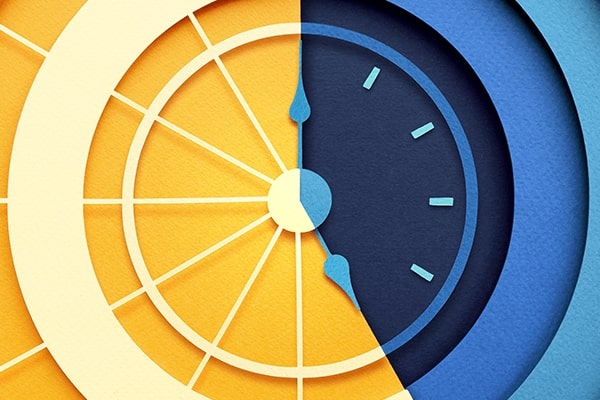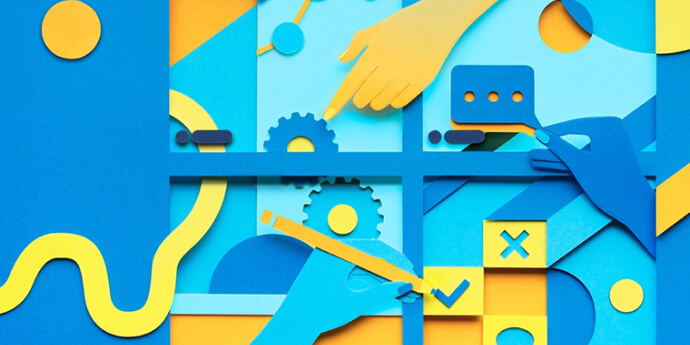
Once upon a pre-pandemic era , working from home sounded like a cozy retreat, particularly for beleaguered commuters or those scampering on a hamster wheel of nonstop business travel. Then came COVID-19, when daydreams of, say, afternoon naps or Ping-Pong breaks with the neighbors gave way to reality. For many people during the coronavirus shutdown, “working from anywhere” turned out to mean working from everywhere around the house, and that’s where new challenges began.
Work-life balance isn’t easy when your job becomes the thousand-pound gorilla in the living room. With millions of us toiling at home for longer hours, especially outside the traditional 9 to 5, there’s never been more blending between what we do and where we live. But at what cost? Research shows that our brains are fatigued by videoconferencing. Working parents find it difficult to juggle household demands. Focus and collaboration are tougher than ever right now.
Those are some of the findings of Microsoft’s most recent Work Trend Index report, which looked at how remote workers around the world are coping under work-from-home orders. Among many fascinating conclusions, one stands out for those feeling strained by endless online meetings and screen interaction: Disconnecting is essential. The report recommends regular breaks from work and devices every two hours to let your brain refresh, limiting meetings to 30 minutes, and interrupting long tasks with small breaks when possible. But that’s just a start. If we can’t regularly pull ourselves away from our jobs, burnout is inevitable and we will cease to be creative.

Illustration by Owen Gildersleeve
“Normally there’s a space for work and a separate space for your private life, but our work environment...has been implanted into the home environment and that’s created a lot of friction,” says Shamsi Iqbal, principal researcher in Microsoft Research’s Productivity and Intelligence group.
Without clear boundaries, she says, many people fall victim to Parkinson’s law , which holds that work expands to fill whatever time is available for its completion. That results in mental and physical exhaustion, increased sick days, and overall productivity drain as overtaxed employees “work harder but not smarter,” Iqbal says.
Setting Boundaries for Better Work Habits
So, what’s an out-of-balance workhorse to do? A look around the world at how workers switch off shows the value of drawing a bright shining line between the daily grind and everything else.
Consider the German concept of feierabend , or “celebration of evening.” You hear the word around the close of the business day, usually as a hearty farewell. Wishing your coworker schönen feierabend marks the moment you’ve wrapped that last work meeting or memo to the boss. There’s really no translation for it in English. But even in one of Europe’s most productive nations, feierabend —like the siesta in warmer climates and il dolce far niente (“the sweetness of doing nothing”) in Italy—is a cultural nod that work is just one part of who you are.
“The idea is to prioritize leisure and relaxation as much as checking off items on the bottomless to-do,” says Ashley Whillans , assistant professor at Harvard Business School and author of Time Smart: How to Reclaim Your Time and Live a Happier Life . She studies decisions people make about time in their jobs, relationships, and personal lives. A closing work ritual like feierabend “lets you celebrate what you’ve accomplished rather than focusing on what can probably wait until tomorrow.”
It is a rite more of us should probably adopt. Drawing data from one of the largest graphs ever assembled on human work activity, Microsoft’s Work Trend Index revealed some unsettling trends, and not just that 31 percent of U.S. frontline and information workers in the study said the pandemic has increased their feelings of burnout at work (compared with 10 percent in Germany). We’re also just working more. During the first few months of the pandemic, after-hours Microsoft Teams chats increased by 69 percent per person. Weekend work surged, too, with Teams chats on and Saturday and Sunday increasing more than 200 percent. To help better manage time in an always-on environment, Teams introduced features such as a focus status to let coworkers know you are engaged in focused work. Adjusting settings for quiet hours and quiet days silences notifications in Teams at those times.
Work-life balance isn’t easy when your job becomes the thousand-pound gorilla in the living room.
Communicating those needs at home is just as valuable, Iqbal says. “Around the world people are missing cues that come so easily in person in office settings, so we need to be clear with our needs,” she says. “When you’re at home with four people with different schedules, it’s important for everyone to know the ground rules. If I’m in a remote meeting and my sound and screen are off, my kids can come and interrupt me. The first thing they do when they walk into the room is say, ‘Are you on mute?’ The pandemic is forcing us to rethink these basic social cues.”
That’s also true with ramping up for work and winding down at the end of the day. We may not have feierabend in the U.S., but millions of us are familiar with the mind-clearing practice known as the rush-hour commute. For years, Iqbal and her research teams have been examining ways to incorporate the more reflective parts of that maligned routine as a way to help Microsoft employees disconnect. The commute offers time without interruption to mentally switch modes at the edges of the day. Virtual Commute was implemented as a product this year that lets users ease transitions “to and from” work, even if they never leave home. It lets you meditate with Headspace, close out tasks from email and Teams, and rate how you are feeling about the day with an emotional check-in that’s available only to you but helps you notice patterns over time.
Above all, Virtual Commute sets a boundary. “It’s a way to signal that the workday is over and that it’s time to take care of yourself,” Iqbal says, adding that such seemingly small interventions can make a major impact. In the Work Trend Index, 6 in 10 people reported that they were more productive when their digital assistant helped them ease into and out of work, with productivity increasing between 12 and 15 percent. Other research has shown that using a meditation app decreases stress by 32 percent.

Illustration by Owen Gildersleeve
Remote Workers Need “Out of Office” Breaks, Too
Wearing pajamas to a meeting might sound relaxing, but working from home isn’t exactly a spa vacation. The Work Trend Index reported that overwork and stress during the pandemic are high. In particular, video meetings are more emotionally draining than non-meeting work, and reduced nonverbal cues make it harder for remote workers to “read the room” or even know exactly when to talk during online meetings.
With sustained concentration fatigue setting in around 30 to 40 minutes into a meeting, according to the study, it’s important to punctuate videoconferences with breaks. Those half-hour limits and breaks every two hours, as recommended in the study, go a long way, but there’s more to be done.
Nature is a great place to recharge. That might mean a stroll around the block to get sunlight or a midday hike or trail walk if you have access. In Japan, where rates of office stress are among the highest anywhere, Dr. Qing Li, a physician and president of the Japanese Society of Forest Medicine, conducted a study to see whether meditative walks in nature—or “forest bathing,” as Li called it—could improve sleep patterns among middle-aged Tokyo office workers who tended to suffer from stress-related insomnia. Not only did Li’s nature-going subjects sleep better, they also slept longer and reported less anxiety. Walking in the afternoon during a stressful day proved to be even more therapeutic in this regard than morning walks.
As a strategy for disconnecting, forest bathing has gone viral around the world, and it shows how mindsets about work-life balance are changing. The Japanese government last year implemented a new Work Style Reform Bill with eight key labor laws, from caps on excessive overtime hours to a mandate for employees to take at least five vacation days per year. At root is the idea that a work environment needs to be as emotionally supportive as it is productive.
“People are missing cues that come so easily in person in office settings,” Shamsi Iqbal says. ”
Microsoft research shows that employee wellbeing is more important to productivity than ever, and nurturing a happy, healthy, creative environment is a big part of that. The recent introduction of the Reflect messaging extension gives managers, leaders, and teachers a way to check on how their team or students are feeling—either in general or about a specific topic like work-life balance, the status of a project, current events, or a change within the organization. Likewise, new shared features of PowerPoint and meetings software, such as live reactions and chat bubbles, offer options for people to participate in the discussion without having to jump in verbally.
The unspoken premise of all these efforts is that people should work to live, and not vice versa. Once again, it helps to look to the German lexicon for its fine-tuned verbal take on maintaining a healthy work-life balance. In addition to wishing one another a happy feierabend , workers use the office greeting mahlzeit (a composite of “meal” and “time”) to remind one another not to schedule meetings around the all-important, highly social lunch break. Erst die Arbeit, dann das Vergnügen translates as “first work, then pleasure.” And here’s a mouthful that says it all, and speaks to the need of hardworking employees everywhere to cut back and chill, without guilt: Arbeitsunfähigkeitsbescheinigung is a curious combination of the German words for “work,” “inability,” and “certificate”—literally a certifiable inability to get stuff done—and can be all the excuse you need to take a day off with zero questions asked. After a year as stressful as 2020, there should be a word for that in every language.

